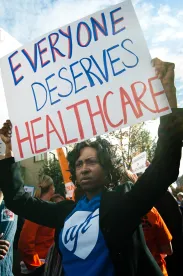More than 13 million people were enrolled in Medi-Cal in California in September 2021, making it the largest Medicaid program in the nation. In December 2021, the Centers for Medicare & Medicaid Services (CMS) approved the California Department of Health Care Services’ (DHCS’) request for a five-year extension of its Medicaid section 1115 demonstration and a five-year extension of its Medicaid managed care section 1915(b) waiver. These Medicaid waivers are part of the “California Advancing and Innovating Medi-Cal” (CalAIM) initiative which was launched in January 2022 to provide aid to California’s most vulnerable residents and to provide more equitable programs and access statewide.
CalAIM seeks to build upon the county-based Whole Person Care (WPC) and plan-based Health Homes Program (HHP) pilots to focus on social determinants of health to address the health needs of individuals experiencing homelessness, behavioral health care access, children with complex medical conditions, the growing number of justice-involved populations who have significant clinical needs, and seniors and individuals living with disabilities. It envisions enhanced coordination, integration, and information exchange among managed care plans (MCPs); physical, behavioral, community-based, and social service providers; and county agencies.
In 2015, DHCS launched the WPC Pilots as part of its Medi-Cal 2020 Section 1115 Demonstration. It was a $3 billion Medicaid Section 1115(a) waiver demonstration project that tested patient-centered interventions in which eligible beneficiaries received care coordination and other services through partnerships of county health agencies, Medicaid MCPs, community-based providers, and other public agencies. Pilots had the flexibility to tailor their programs based on regional needs and availability of resources and were encouraged to develop data sharing infrastructure for effective coordination and tracking of progress.
In 2018, DHCS also launched the HHP pilot. The HHP served eligible Medi-Cal managed care plan Members with complex medical needs and chronic conditions who could benefit from intensive care management and coordination. The HHP provided six core services: Comprehensive care management; Care coordination (physical health, behavioral health, community-based long-term services); Health promotion; Comprehensive transitional care; Individual and family support; and Referral to community and social support services, including housing.
Both programs have seen early success: For WPC, in 2020, DHCS released findings that the emergency department visit rate of enrollees had decreased from 214 to 181 visits per 1,000 members, inpatient utilization rate had decreased from 75 to 59 visits per 1,000 members, and justice-involved individuals experienced a 29% increase in controlling of their blood pressure. Similarly, for HHP, the emergency department visit rate of enrollees decreased from 404 to 285 visits per 1,000 members, inpatient utilization rate had decreased from 134 to 91 visits per 1,000 members after a year of the program, and the rate of initiation and engagement of substance abuse treatment increased significantly for HHP enrollees from 45% to 55%. Consequently, these results directly influenced the design of CalAIM.
CalAIM has established an Enhanced Care Management (ECM) benefit, which provides intensive whole-person care management and coordination to address the clinical and nonclinical needs of Medi-Cal members with complex needs. ECM benefits are administered by MCPs: Plans identify members in each of the ECM target populations and assign them to “ECM providers” responsible for conducting outreach and for coordinating and managing care across a broad spectrum of physical, behavioral, and social service providers. ECM will be accounted for in MCP capitation rates, meaning that once the program is fully implemented, MCPs must provide the benefit to Members if they request it.
If successfully implemented, ECM will ensure that enrollees with complex needs are identified and engaged by someone who understands their goals, develops a plan in partnership with them and their providers, and actively connects them with the clinical and nonclinical services and resources that help them meet those goals. DHCS has designated a dozen specific populations of focus (PDF) for the ECM benefit, and managed care plans can add to that list at their discretion.
CalAIM has also established an In Lieu of Services (ILOS) community supports program, which provides cost-effective, health-supporting services that may be substituted for existing State Plan–covered services to reduce hospitalization and institutionalization, reduce cost, and address underlying drivers of poor health. DHCS will allow 14 ILOS categories, including housing transition and navigation services, respite care, day habilitation programs, and nursing facility transition support to an assisted living facility or a home. MCPs may choose which ILOS to cover, in which counties, and to which members the ILOS are offered. These are services that MCPs are strongly encouraged, but not required, to provide as medically appropriate and cost-effective alternatives to utilization of other services or settings such as hospital or skilled nursing facility admissions.
Financially, CalAIM is designed to complement the State’s Home-Based Community Services (HBCS) spending plan, which CMS conditionally approved on January 4, and to assist in drawing down additional federal funding via the American Rescue Plan Act Providing Access and Transforming Health (PATH) component. From a county perspective, it seeks to reduce the state and federal red tape and bureaucratic delays imposed on counties by transitioning from a cost-based reimbursement model to a rate-based intergovernmental transfer model. Thus, it is expected to decrease administrative burdens, speed up reimbursement processes, and streamline the auditing process.
In light of CalAIM, health plans are required to develop networks for ECM and Community Supports in ways that preserve critical infrastructure developed under HHP and WPC. Since ECM and ILOS are community-based services, Medi-Cal managed care members receiving these services will have primarily in-person encounters with community-based providers rather than telephonic encounters. Additionally, health plans must establish contracts with providers and community-based organizations (CBOs) to provide both ECM and ILOS, starting with serving transitioning populations in early 2022. Finally, to maintain HHP and WPC infrastructure, health plans are specifically required to work towards contracts with WPC Lead Entities (counties) & Community Based Care Management Entities (CB-CMEs) as ECM & Community Supports Providers.
These programs also place certain requirements on providers. For example, ECM providers must act as the primary responsible entity for coordinating care across multiple health systems, designate a lead care manager for each member receiving the benefits, and contract with health plans to meet specific contractual requirements and demonstrate certain capabilities related to care models and data sharing. Similarly, ILOS providers must deliver critical medical and social services, such as housing navigation, recuperative care, medically-tailored meals, or community transitions, which are not typically funded by Medi-Cal, contract with health plans as the primary responsible entity for delivering select medically appropriate alternatives to more costly state plan services, and also meet certain contractual requirements and demonstrate certain capabilities related to care models and data sharing.
By focusing on population health, implementing payment reforms, and ensuring greater accountability for MCPs, DHCS expects that CalAIM will result in a better quality of life for Medi-Cal members as well as long-term cost savings. We will continue to monitor CalAIM’s progress to understand how the coordination of care through programs like ECM and ILOS may improve on cost, quality, and access to healthcare.
Sheela Ranganathan also contributed to this article.



 />i
/>i
